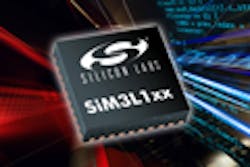Power-Aware Tools Complement Low-Power 32-Bit MCU
Active-mode power reduction is achieved through a number of innovations. For example, dynamic voltage scaling adjusts the internal device voltage in response to changing conditions. An integrated, high-efficiency dc-dc buck converter reduces active-mode power. Dedicated peripherals such as a data transfer manager, AES encryption block, and run-time encoder accelerate the processing of RF protocol for wireless applications without CPU intervention, reducing system power. Enhanced direct memory access (DMA) can reduce protocol-related power by 90%.
On-chip peripherals have also been optimised to reduce sleep-mode power. The charge pump generates a power-efficient input voltage for the device circuits in sleep mode, which reduces analogue sleep currents by 35% and digital sleep currents by 50%. Also, the SiM3L1xx MCUs support a multi-alarm RTC for clocking and interrupts and a sleep-mode UART for low-power device communication. An integrated sensor interface provides sensor stimulus and measurement while the MCU is in sleep mode. The autonomous sensor interface continues to count in sleep mode and can wake the MCU after a count overflow or when the count reaches a programmable threshold.
Silicon Labs has also introduced two capabilities for lowering power consumption to its complimentary Eclipse-based integrated development environment (IDE) and AppBuilder software for Precision32 MCUs. Power Estimator provides a pie chart of total supply current and additive currents for enabled peripherals to show where power is being consumed, while Power Tips provides software configuration guidance that helps minimise current consumption.
About the Author
Staff
Articles, galleries, and recent work by members of Electronic Design's editorial staff.
